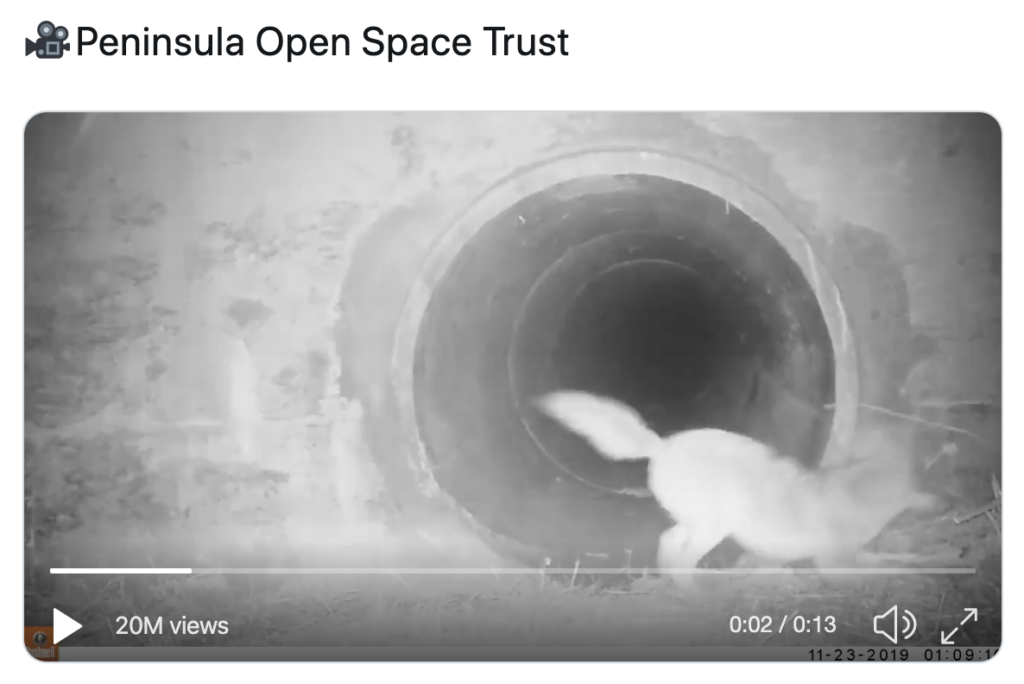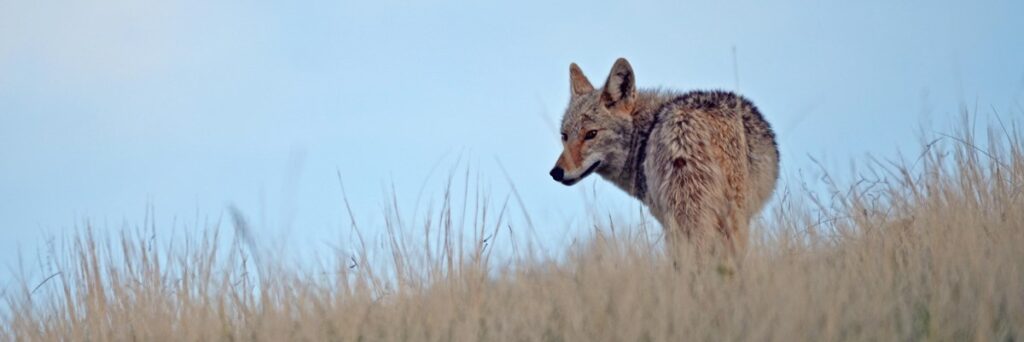
Here we see a coyote exhibiting what we identify in domestic dogs as a “play bow”. He’s seemingly inviting the badger (off screen) to follow him through the culvert.
By now, you may have seen the viral video of a coyote and a badger entering a culvert that passes under a busy California highway in the Santa Cruz Mountains. In this video, we are presumably seeing the pair traveling together toward hunting grounds, avoiding the danger of a busy highway. It has long been known that coyotes and badgers will hunt ground squirrels together. It makes sense for coyotes and badgers to team up as they seem to have complementary hunting skills. The coyote is adept at capturing prey above ground while the badger can dig after prey if they escape into burrows. Minta et al. (11) reported that badgers reduced “long-range scanning” (propping their head and body up) during associations with coyotes, suggesting that badgers benefited from the coyote’s superior detection abilities. At the same time, compared to when hunting alone, coyotes had a higher success rate of capturing ground squirrels when hunting with a badger. If you’re a ground squirrel or other burrowing rodent, you’re probably in deep trouble if a badger-coyote team has you trapped.
Are Coyote/Badger Friendships Unusual?
Beyond being adorable, the video of this badger-coyote duo demonstrates that the coyote, like the domestic dog, can form relationships with a different species. The ability to develop mutualistic relationships with another species is more often seen in social species (13). After all, the ability of wild canids to associate with another species ultimately gave rise to the domestic dog (3) that we share our homes with today.
Despite their mutualistic hunting, the coyote and badger are competitors. In some areas, coyote control is associated with an increase in the badger population (8). They are both predators competing for the same food source who sometimes directly kill each other (9). (Sorry to ruin your harmonious picture of coyote-badger friendship!) How did these two rivals end up forming a hunting relationship observed by humans for centuries (4, 6, 1, 7, and 12)?
“However, recurring pairs of the same individuals have been observed, with familiar pairs showing less aggression towards each other and behaving in ways that maintain the relationship (11). This suggests that individuals learn from previous positive hunting experiences together, and explains what we’re likely seeing in the viral post.”

Cahalane and Lehner (2, 10) observed that coyotes and badgers will follow each other and change leaders. This implies some form of mutualism, a relationship in which both the coyote and badger have increased success when hunting together. On a short-term basis, success for each individual is varied and may depend on local habitat and seasonal variations in prey abundance and density (11, 14). However, recurring pairs of the same individuals have been observed, with familiar pairs showing less aggression towards each other and behaving in ways that maintain the relationship (11). This suggests that individuals learn from previous positive hunting experiences together, and explains what we’re likely seeing in the viral post. While the few studies investigating this relationship have been inconsistent in finding mutualism (2, 4, 11; 15; 5, 4), they have also been limited by the fact that until now biologists haven’t been able to observe what badgers are actually doing underground. It is believed that if a coyote is above ground, badgers tend to eat their prey in the burrow (11). This makes sense for the badger – why share when you don’t have to? It’s been easy to document coyote and badger’s above ground hunting behavior and success rates. Modern camera trapping technology may open up new methods of recording (14) and change our understanding of this phenomenon.
Behavioral Economics At Play
The bottom line is that this is a system that works, at least sometimes, for both species. The fluid social and predatory behavior between coyotes and badgers occurs since more often than not, working together pays off (11). The success of a hunt and the reinforcement of a good meal outweighs the risk of injury or death. In other words, both animals are motivated to work together.
What can dog trainers learn from the coyote-badger hunting association? First, an ability to connect to another species is a trait that is seen in the wild canids, but has been strongly selected for in the dog through first natural and then artificial selection. In other words, dogs have been genetically programmed to associate with humans in ways that are unique only to them. Just last week I worked with Ryan, an 8-month old male Catahoula Leopard Dog mix who had just landed at my shelter. The shelter building was undergoing construction and Ryan was distressed by the banging and drilling. He paced and fretted around the training room, unable to settle. Then, I sat on the floor and he came over to lay down next to me with his head in my lap. In his moment of distress, he found comfort from a human stranger. Meanwhile, I fell in love with his warmth, cuddles, and puppy dog eyes. If this isn’t a mutualistic relationship, I don’t know what is.

Any respectable dog trainer understands that you can’t teach anything to a dog without a relationship and a good understanding of your learner’s motivation. It really is that simple. If there is a system in place that works for the dog, you don’t need any magic tricks, shortcuts, or “whispering” energy. Good trainers have great observational skills and understand what is motivating their learner at any given moment. All we do is manipulate contingencies that increase motivation so we can shape and reinforce the behaviors we’re looking for.
References
(1) Aughey, S. (1884). Curious companionship of the coyote and the badger. The American Naturalist, 18, 644-645.
(2) Cahalane, V. (1950). Badger-coyote “partnerships”. Journal of Mammalogy, 31, 354-355.
(3) Coppinger, R. and Coppinger, L. (2001). Dogs: A New Understanding of Canine Origin, Behavior, and Evolution. The University of Chicago Press, pp. 352.
(4) Dobie, J. (1950). The Voice of the Coyote. Boston: Little Brown and Company.
(5) Dobie, J.F., Boatright, M.C., & Ransom, H.H. (1965). Coyote Wisdom. Dallas: Southern Methodist University Press.
(6) Goodwin, G. (1939). Myths and Tales of the White Mountain Apache. New York: The American Folklore Society.
(7) Hawkins, A. (1907). Coyote and badger. The Ottawa Naturalist, 21 (37).
(8) Henke, S. (1992). Effect of coyote removal on the faunal community ecology of a short-grass prairie. (Doctoral dissertation). Retrieved from
(9) Kiliaan, H., Mamo, C. & Paquet, P. (1991). A Coyote, Canis latrans, and Badger, Taxidea taxus, interaction near Cypress Hills Provincial Park, Alberta. Canadian Field Naturalist, 105, 122-123.
(10) Lehner, P. (1981). Coyote-badger associations. Great Basin Naturalist, 41 (3), 347-348.
(11) Minta, S., Minta, K. & Lott, D. (1992). Hunting Associations between Badgers (Taxidea taxus) and Coyotes (Canis latrans). Journal of Mammalogy, 73(4), 814-820. doi:10.2307/1382201
(12) Seton, E. (1929). Lives of Game Animals. Garden City, New York: Doubleday, Douran and Company.
(13) Thompson, J. (1982). Interaction and Coevolution. New York: John Wiley & Sons.
(14) Thornton, D., Scully, A., King, T., Fisher, S., Fitkin, S., Rohrer, J. (2018). Hunting associations of American badgers (Taxidea taxus) and coyotes (Canis latrans) revealed by camera trapping. Canadian Journal of Zoology, 96(7), 769-773.
(15) Van Wormer, J. (1964). The World of the Coyote. Philadelphia: J.B. Lippincott Co.

